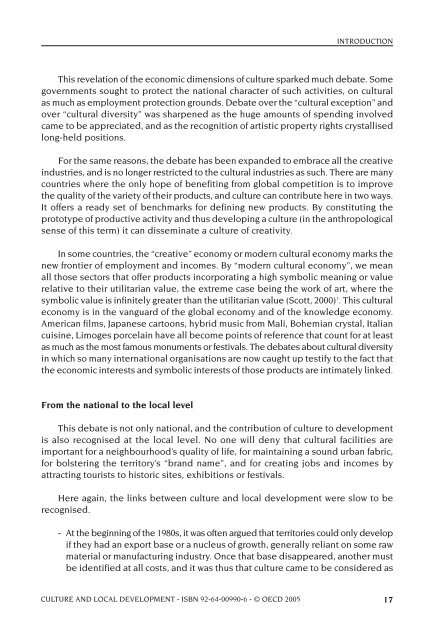OECD Culture and Local Development.pdf - PACA
OECD Culture and Local Development.pdf - PACA
OECD Culture and Local Development.pdf - PACA
You also want an ePaper? Increase the reach of your titles
YUMPU automatically turns print PDFs into web optimized ePapers that Google loves.
INTRODUCTION<br />
This revelation of the economic dimensions of culture sparked much debate. Some<br />
governments sought to protect the national character of such activities, on cultural<br />
as much as employment protection grounds. Debate over the “cultural exception” <strong>and</strong><br />
over “cultural diversity” was sharpened as the huge amounts of spending involved<br />
came to be appreciated, <strong>and</strong> as the recognition of artistic property rights crystallised<br />
long-held positions.<br />
For the same reasons, the debate has been exp<strong>and</strong>ed to embrace all the creative<br />
industries, <strong>and</strong> is no longer restricted to the cultural industries as such. There are many<br />
countries where the only hope of benefiting from global competition is to improve<br />
the quality of the variety of their products, <strong>and</strong> culture can contribute here in two ways.<br />
It offers a ready set of benchmarks for defining new products. By constituting the<br />
prototype of productive activity <strong>and</strong> thus developing a culture (in the anthropological<br />
sense of this term) it can disseminate a culture of creativity.<br />
In some countries, the “creative” economy or modern cultural economy marks the<br />
new frontier of employment <strong>and</strong> incomes. By “modern cultural economy”, we mean<br />
all those sectors that offer products incorporating a high symbolic meaning or value<br />
relative to their utilitarian value, the extreme case being the work of art, where the<br />
symbolic value is infinitely greater than the utilitarian value (Scott, 2000) 1 . This cultural<br />
economy is in the vanguard of the global economy <strong>and</strong> of the knowledge economy.<br />
American films, Japanese cartoons, hybrid music from Mali, Bohemian crystal, Italian<br />
cuisine, Limoges porcelain have all become points of reference that count for at least<br />
as much as the most famous monuments or festivals. The debates about cultural diversity<br />
in which so many international organisations are now caught up testify to the fact that<br />
the economic interests <strong>and</strong> symbolic interests of those products are intimately linked.<br />
From the national to the local level<br />
This debate is not only national, <strong>and</strong> the contribution of culture to development<br />
is also recognised at the local level. No one will deny that cultural facilities are<br />
important for a neighbourhood’s quality of life, for maintaining a sound urban fabric,<br />
for bolstering the territory’s “br<strong>and</strong> name”, <strong>and</strong> for creating jobs <strong>and</strong> incomes by<br />
attracting tourists to historic sites, exhibitions or festivals.<br />
Here again, the links between culture <strong>and</strong> local development were slow to be<br />
recognised.<br />
- At the beginning of the 1980s, it was often argued that territories could only develop<br />
if they had an export base or a nucleus of growth, generally reliant on some raw<br />
material or manufacturing industry. Once that base disappeared, another must<br />
be identified at all costs, <strong>and</strong> it was thus that culture came to be considered as<br />
CULTURE AND LOCAL DEVELOPMENT - ISBN 92-64-00990-6 - © <strong>OECD</strong> 2005 17














